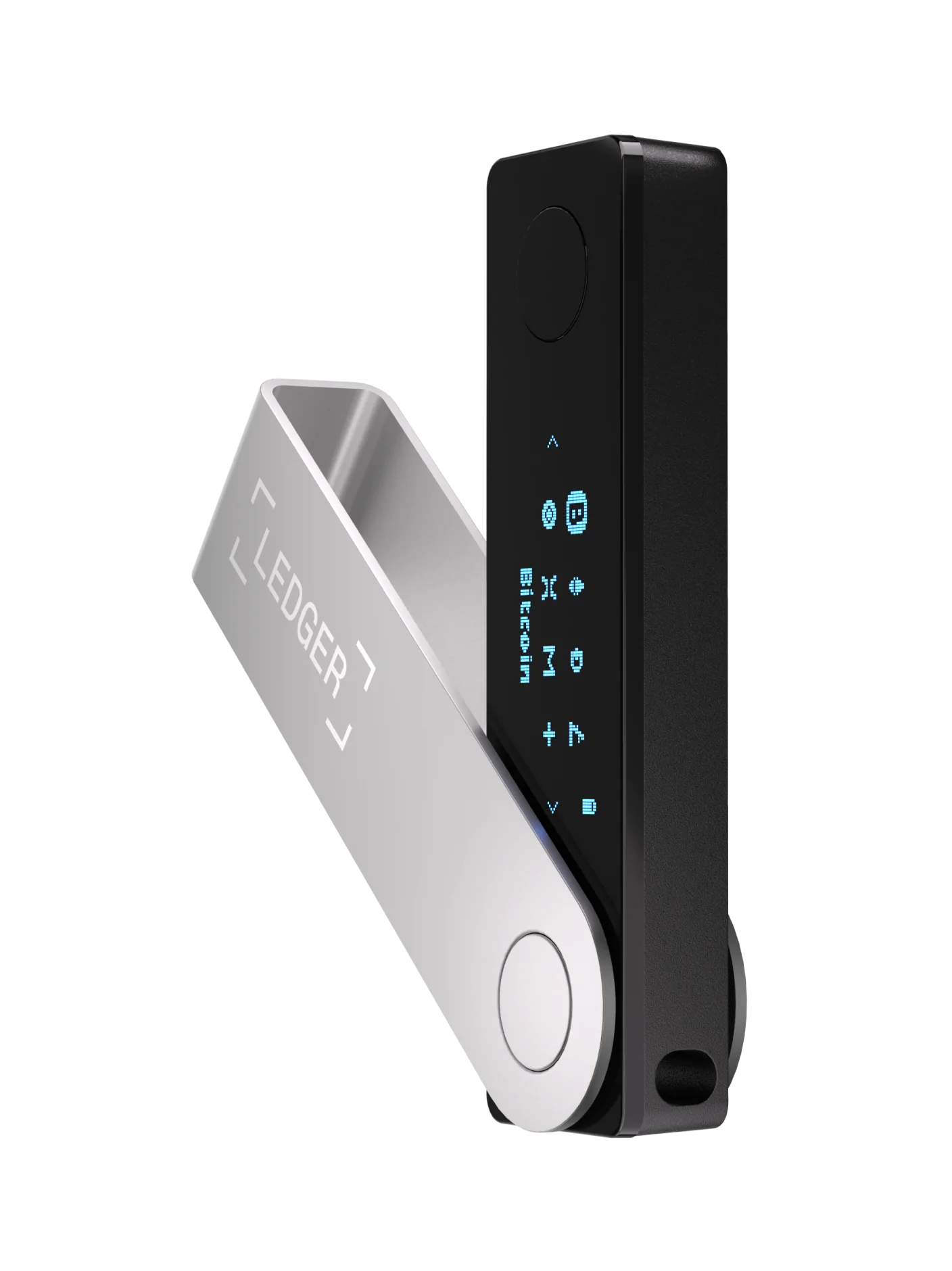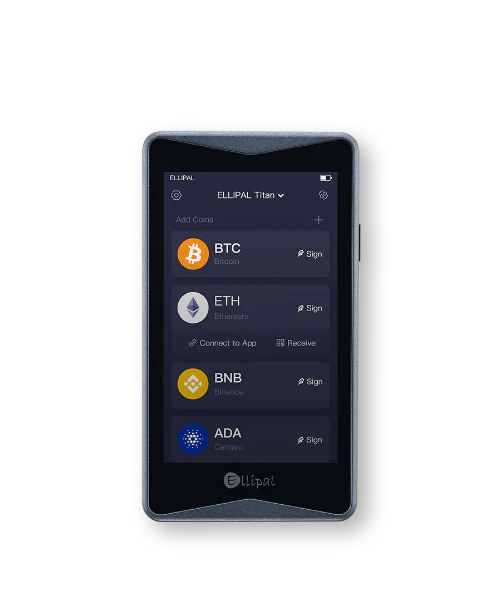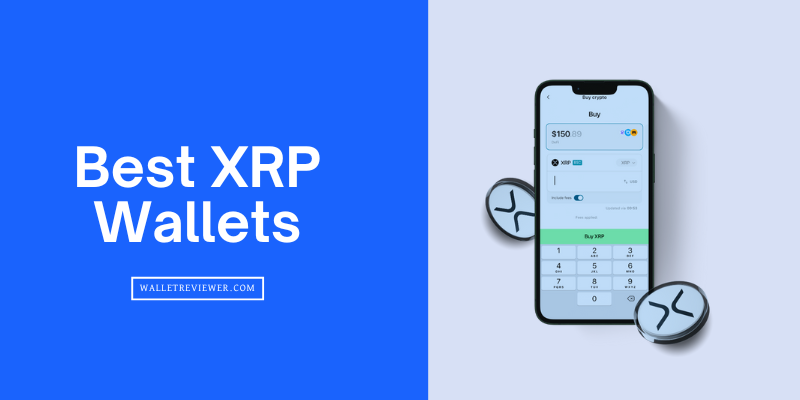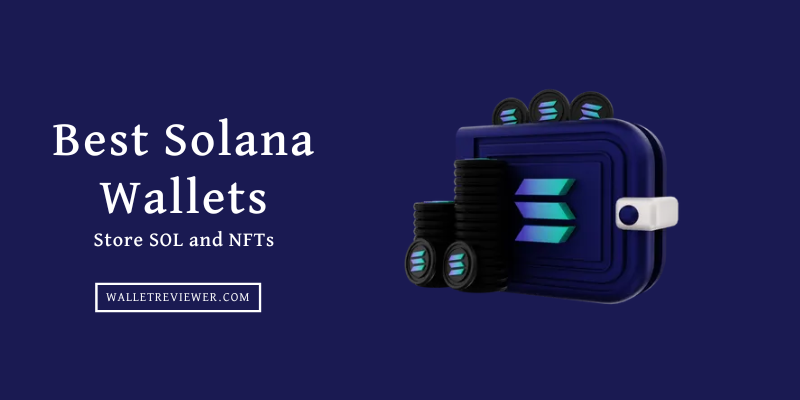Stablecoins are now a crucial bridge between traditional money and digital assets. The number of active stablecoin wallets jumped from 19.6 million in February 2024 to more than 30 million by February 2025.
The overall market cap of these dollar‑pegged tokens exceeded $225 billion in early 2025, and forecasts suggest it could cross $400 billion by the end of the year.
The rapid adoption of USDT and USDC means that choosing the right wallet is essential for safety and convenience. You need security against hacks, broad network support, and ease of use. This guide compares the best stablecoin wallets available in 2025, highlighting hardware and software options for long‑term storage, everyday payments, and DeFi participation.
7 Best Stablecoin Wallets for Safe Storage 2025
- Ledger Flex: Best Stablecoin Hardware Wallet (Trusted by 10 million users)
- ELLIPAL Titan 2.0: Best Cold Wallet for Stablecoins (no WiFi, no Bluetooth; QR-code based)
- Trezor Safe 5: Safest Wallet for USDT and USDC (Transaction mixing and Tor support)
- NGRAVE ZERO: Air‑gapped USDT Wallet (EAL7 Certified OS)
- Trust Wallet: Best for Storing TRC-20 and BEP-20 Stablecoins (Mobile wallet)
- Coinbase Wallet: Best for Storing USDC and DeFi Wallet (by Coinbase Exchange)
- MetaMask: Top Stablecoin Storage Wallet for the ERC-20 Network
My Picks: Safest Stablecoin Wallets for USDT and USDC
Top 7 Wallets to Store Stablecoins Securely Reviewed
1. Ledger Flex: Best Stablecoin Hardware Wallet
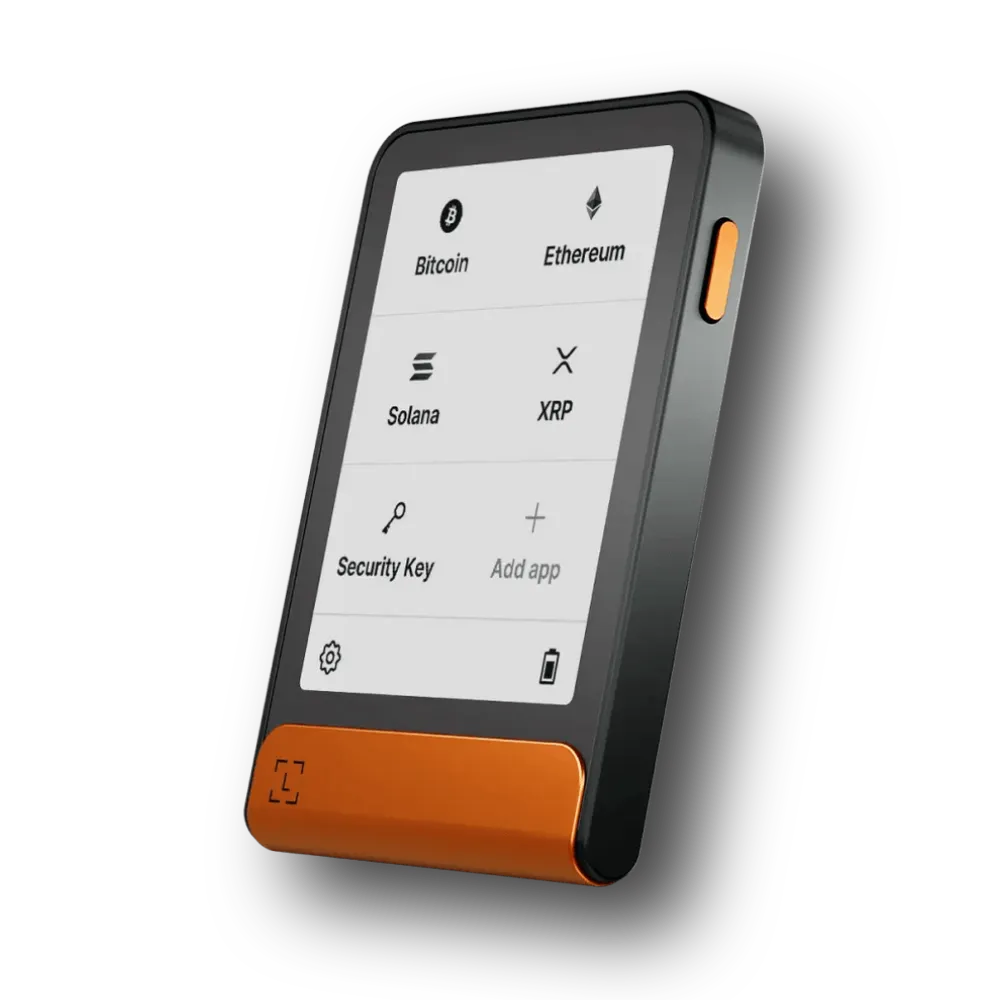
Ledger has been a household name in crypto security since 2014. Its Ledger Flex model, released in 2025 to celebrate the company’s tenth anniversary, offers next‑generation protection for stablecoin holders. A 2.84‑inch monochrome E‑Ink touchscreen provides low‑power readability and quick navigation.
Security starts with a Secure Element microprocessor certified to the CC EAL6+ standard. The chip undergoes rigorous testing and isolates applications from each other, so private keys remain protected even if a software component is compromised. Ledger Flex stores keys completely offline and has no Wi‑Fi connectivity, reducing the chance of remote hacks.
The wallet uses a 24‑word Secret Recovery Phrase, a multi‑signature option, two‑factor authentication, and a 4–8 digit PIN. A “Protection Mode” automatically locks the device when a threat is detected. Ledger Live, the companion app, shows transaction details in human‑readable form, lets you buy or swap tokens, and supports over 5,500 assets, including USDT and USDC.
You can stake supported stablecoins through integrated DeFi apps and monitor yield in real time. Extra accessories, such as Ledger Security Key and the free Ledger Recover key, provide additional backup options. The long battery life of up to 10 hours keeps the device portable.
Hence, for stablecoin users seeking industry‑leading security with convenient DeFi access, Ledger Flex is one of the best stablecoin wallets available.
2. ELLIPAL Titan 2.0: Best Cold Wallet for Stablecoins
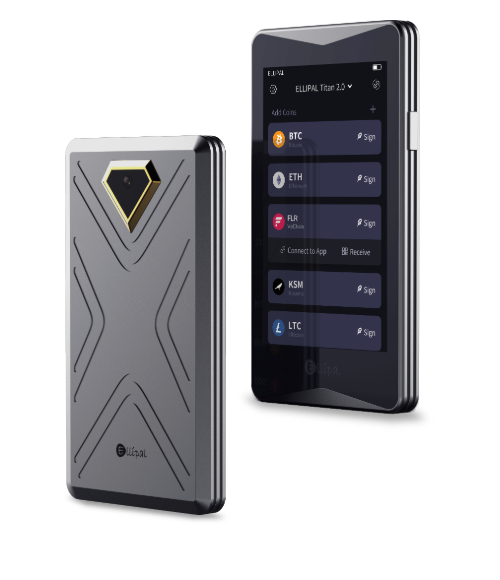
ELLIPAL Titan 2.0 is a fully air‑gapped stablecoin wallet designed to store your stablecoins offline. The device stores private keys completely offline and avoids Wi‑Fi, USB, and Bluetooth connections. Data transfers happen via scannable QR codes, eliminating network exposure.
The Titan supports over 10,000 tokens across more than 50 blockchains, including Bitcoin, Ethereum, and Solana. It integrates with WalletConnect to access DeFi applications and swap USDT or USDC directly from your cold wallet.
Security features include a tamper‑resistant build with a self‑destruct mechanism; if someone attempts to open the case, the device wipes all data. Firmware updates occur offline via a microSD card, preserving the air‑gapped design. The CC EAL5+ certified secure element enhances resistance to physical attacks. ELLIPAL also offers a Seed Phrase Steel accessory, an aviation‑grade stainless steel plate that is fireproof and waterproof, ensuring your recovery phrase survives extreme events.
Because all transactions are signed offline, the Titan 2.0 is ideal for long‑term storage of stablecoins. It supports USDT, USDC, and DAI on networks like Ethereum and Tron, letting you send or receive tokens via the companion mobile app. The interface is intuitive, with large icons and a simple setup process. You can connect the Titan to DeFi platforms through QR codes for staking or lending. For users who prioritise offline security but still want some DeFi functionality, ELLIPAL Titan 2.0 is one of the best stablecoin wallets.
3. Trezor Safe 5: Safest Wallet for USDT and USDC

Trezor’s Safe 5 is the newest hardware stablecoin wallet from SatoshiLabs and uses an EAL6+ certified Secure Element chip. The wallet introduces a 20‑word SLIP‑39 backup (Shamir Backup) alongside the traditional 12‑ or 24‑word seed phrase.
SLIP‑39 splits your recovery phrase into multiple shares, allowing more flexible backups and reducing the risk of a single point of failure. A bright colour touchscreen with tactile feedback makes navigation easy, and open‑source firmware means the community can audit the code.
Trezor Safe 5 supports over 1,000 crypto assets, including USDT, USDC, and DAI. The device is simple to operate: connect via USB to your computer or phone, enter your PIN, and confirm transactions on the screen. The wallet has no wireless connectivity, keeping your keys offline.
It offers open‑source security, so you can verify that there are no hidden backdoors. The price is higher than earlier models. However, the improved Secure Element and Shamir Backup make it one of the best wallets to store stablecoins for users who prioritise transparency and safety.
4. NGRAVE ZERO: Air-gapped USDT Wallet (EAL7 Certified OS)
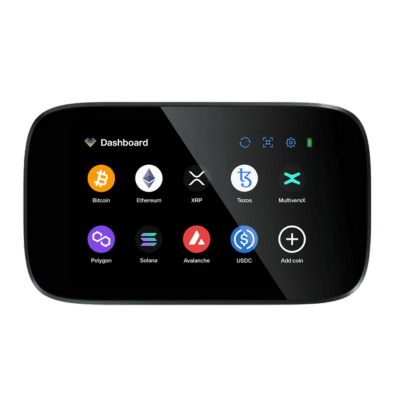
The NGRAVE ZERO is the only stablecoin cold wallet with an EAL7 certification, the highest security standard in the financial industry. Its operating system is custom‑built and fully air‑gapped, meaning the device has no USB, Wi‑Fi, Bluetooth, or NFC connections.
The wallet uses a Perfect Key created entirely offline; your biometrics and environmental randomness ensure that only you can generate the private key. NGRAVE ZERO supports major networks like Bitcoin, Ethereum, Binance Chain, and Solana. It is primarily designed for long‑term cold storage; the Finder review notes that the wallet does not support DeFi or staking.
However, the high price (around US$398 and limited DeFi functionality may deter some users. If your priority is maximum security for large stablecoin holdings, NGRAVE ZERO is a strong choice.
5. Trust Wallet: Best Stablecoin Mobile Wallet for Everyday Use
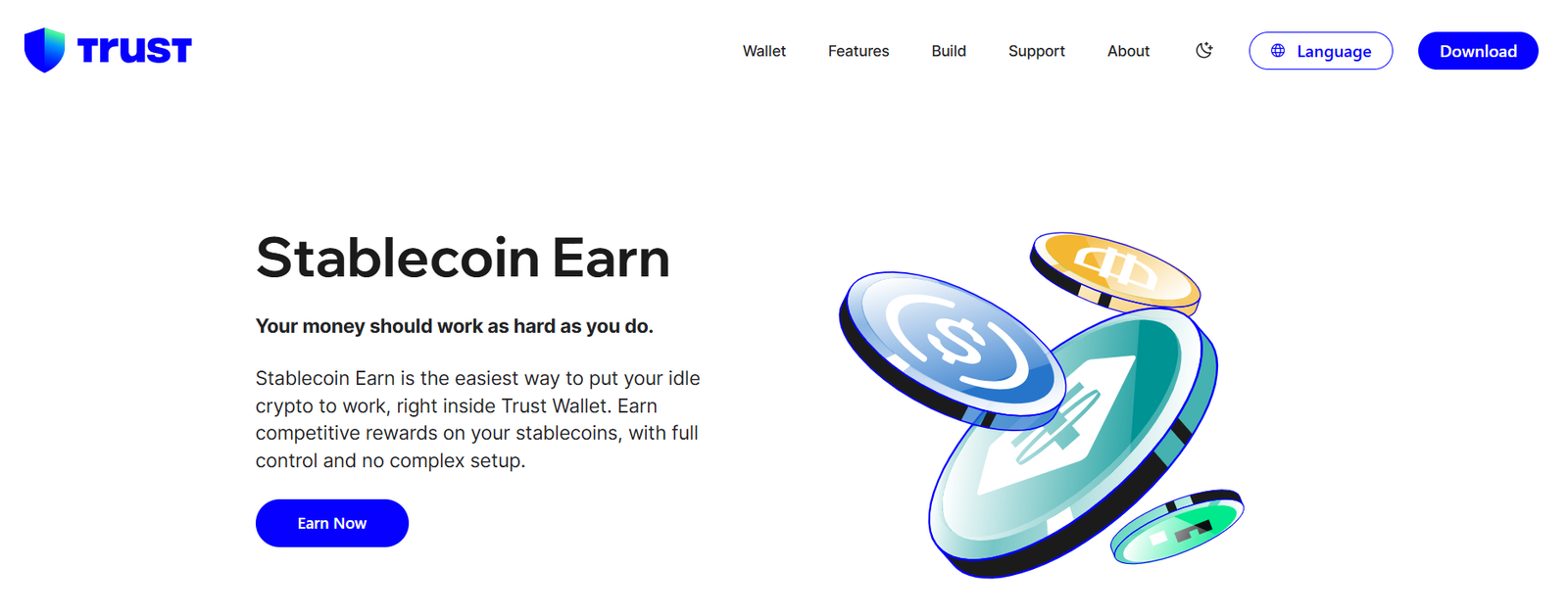
Trust Wallet is a free mobile wallet acquired by Binance in 2018. It supports major stablecoins on Ethereum, BNB Chain, Tron, and Solana and connects to more than 70 blockchains. Trust Wallet emphasises self‑custody; your private keys are stored on your device and never shared with the company.
It receives a CER Security Rating of AAA and a CertiK Skynet Score of 85.24. It’s Pros include the ability to swap tokens inside the wallet and support for a very large number of coins. For stablecoin holders, Trust Wallet is ideal for everyday use, quick transfers, and DeFi access across multiple networks. Also, it is an online wallet, not an offline wallet.
6. Coinbase Wallet: Best USDC DeFi Wallet
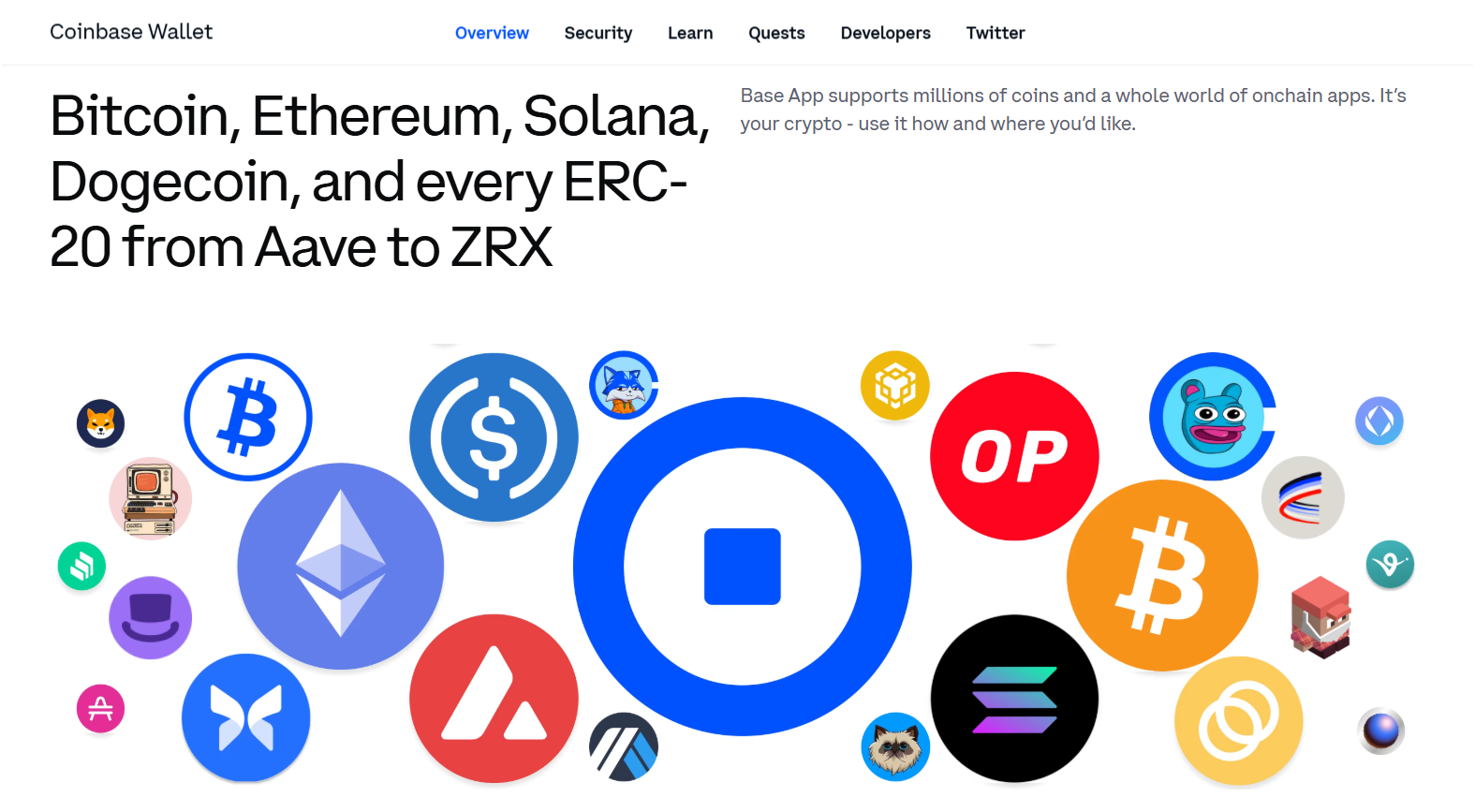
Coinbase Wallet is a non‑custodial wallet from the publicly traded exchange Coinbase. It is best for regulated stablecoin markets and fiat on‑ramps. It offers direct links to the Coinbase exchange, enabling seamless transfers between your wallet and trading account.
The wallet supports USDC, USDT, and other tokens on networks like Base, Optimism, and Ethereum. Hardware wallet compatibility lets you connect Ledger or Trezor for additional security.
Coinbase Wallet stands out for its regulated environment and user education features. It includes transaction previews, biometric authentication, and a dApp blocklist. For stablecoin investors who want easy access to DeFi protocols, on‑ramp services, and strong corporate backing, Coinbase Wallet is one of the best stablecoin wallets.
7. MetaMask: Top Stablecoin Storage Wallet for Ethereum Network

MetaMask is the most widely used Web3 wallet, supporting Ethereum and all compatible EVM networks. It has high security scores (AAA) and a 99.99 % transaction success rate.
MetaMask is open‑source and allows you to customize gas fees, select networks, and add custom tokens. It integrates with hardware wallets like Ledger and Trezor for extra security.
MetaMask introduced Stablecoin Earn, enabling users to deposit USDC, USDT, or DAI into the Aave lending protocol directly inside the mobile app. MetaMask also offers built‑in swaps, token tracking, and an optional MetaMask Card for spending crypto. However, it does not natively support Bitcoin. Still, for stablecoin users focused on the Ethereum ecosystem, MetaMask remains one of the best stablecoin wallets.
Comparing Top Crypto Wallets for Stablecoins
| Wallet | Security certification | Chains & stablecoins supported | Unique features |
|---|---|---|---|
| Ledger Flex | Secure Element (EAL6+) | 5,500+ assets via Ledger Live; supports USDT & USDC | E‑Ink touchscreen; Protection Mode; Ledger Recover |
| ELLIPAL Titan 2.0 | Secure element (EAL5+) | 10k+ tokens on 50+ chains | Air‑gapped QR transfers; Self‑destruct; Seed Phrase Steel |
| Trezor Safe 5 | Secure Element (EAL6+) | 1k+ assets including USDT & USDC | SLIP‑39 backup; open‑source firmware |
| NGRAVE ZERO | EAL7 certification | Supports BTC, ETH, BNB, SOL; ERC‑20 tokens | Air‑gapped with biometric Perfect Key; Graphene backup |
| Trust Wallet | CER AAA rating; Skynet 85.24 | Ethereum, BNB Chain, Tron, Solana | Built‑in swaps, staking & DApp browser |
| Coinbase Wallet | Regulated environment (security via exchange) | Base, Optimism, Ethereum and more | DeFi access with fiat on‑ramp; hardware wallet support |
| MetaMask | AA–AAA security rating; 99.99 % success | Ethereum & EVM networks | Stablecoin Earn (Aave integration); large dApp ecosystem |
What is a Stablecoin?
A stablecoin is a digital token designed to maintain a stable value, typically pegged to a fiat currency like the US dollar. Unlike volatile cryptocurrencies such as Bitcoin, stablecoins hold a one‑to‑one value by holding reserves (cash, treasuries) or using collateralized crypto assets.
Popular examples include USDT (Tether), USDC (USD Coin), and DAI. Stablecoins grew rapidly during 2024–2025; the number of active wallets rose by 53 % and the market cap exceeded $225 billion.
Stablecoins enable fast international payments, on‑chain savings, and access to DeFi, making them attractive for both retail and institutional users.
Read More:
- Best cold storage wallets
- Best crypto hardware wallets
- Best NFT wallets
- Best Bitcoin wallets
- Best XRP wallets
What is a Stablecoin Wallet?
A stablecoin wallet is a digital or physical tool that allows you to store, send, and receive stablecoins securely. It manages your private keys, the cryptographic codes that prove ownership of USDT, USDC, or other tokens, and interacts with blockchain networks. Wallets come in two main types:
- Hot wallets (software) run on phones or browsers. Examples include Trust Wallet, Coinbase Wallet, and MetaMask. They remain connected to the internet for quick transactions and DeFi access. Their convenience comes with higher exposure to hacking risks.
- Cold wallets (hardware or paper) keep private keys offline. Ledger Flex, ELLIPAL Titan 2.0, Trezor Safe 5, and NGRAVE ZERO fall into this category. They offer higher security by isolating keys from online threats, though they require physical access to sign transactions.
The best stablecoin wallet should support multiple networks (e.g., Ethereum, Tron, Solana), offer strong encryption, and provide features like staking, swaps, or passive income. Some wallets include biometric authentication, multi‑signature options, or regulatory compliance modules.
How to Pick a Secure Stablecoin Wallet for Long-Term Storage?
You should choose the best stablecoin crypto wallet based on several factors:
- Security certification and design: Look for wallets with high evaluation assurance levels such as EAL6+ or EAL7, a secure element chip, and hardware tamper protection. Air‑gapped wallets like NGRAVE ZERO and ELLIPAL Titan 2.0 keep keys completely offline.
- Network and asset support: Ensure the wallet supports the chains and stablecoins you plan to use. Trust Wallet covers Ethereum, BNB Chain, Tron, and Solana, while Ledger Flex connects to thousands of assets via Ledger Live.
- Ease of use: A touchscreen interface, clear instructions, and a companion app make setup and transactions easier. Ledger Flex and ELLIPAL Titan both have touchscreens for intuitive operation. Software wallets like MetaMask and Trust Wallet offer simple interfaces on mobile and desktop.
- Backup and recovery options: Consider how the wallet handles seed phrases. Trezor Safe 5’s SLIP‑39 backup splits your recovery key into multiple shares. NGRAVE provides a Graphene steel backup for physical resilience.
- DeFi and earning features: If you want to earn yield, check whether the wallet integrates with lending protocols. MetaMask’s Stablecoin Earn taps into Aave for passive income. Trust Wallet offers staking and token swaps.
- Regulatory considerations: Institutional users may favour wallets that integrate compliance tools or are backed by regulated companies. Coinbase Wallet provides direct fiat on‑ramps and a regulated environment.
Assess these factors based on your stablecoin usage. A hardware wallet is best for large stablecoin holdings and long‑term savings, while a stablecoin hot wallet suits active traders and DeFi users.
How to Buy Stablecoin?
Buying stablecoins involves a few simple steps:
- Choose a platform – Sign up for a regulated exchange (Coinbase, Binance) or use the buy‑crypto feature in a wallet like Trust Wallet or MetaMask. Complete the required KYC verification.
- Deposit funds – Add fiat currency via bank transfer, credit card, or payment service. Some wallets offer on‑ramps that convert your local currency directly to stablecoins.
- Select a stablecoin – Choose USDT, USDC, or DAI, and pay attention to the network (ERC‑20 on Ethereum, TRC‑20 on Tron, etc.). Fees vary depending on the chain.
- Confirm purchase – Review the amount, address, and network. Hardware wallets require you to confirm the transaction on the device screen.
- Transfer to your wallet – Withdraw stablecoins to your personal wallet address. Always double‑check addresses, as blockchain transactions are irreversible.
Once purchased, you can hold your stablecoins or use them for payments, trading, staking, or cross‑border transfers.
Can I Earn Interest on Stablecoins Stored in My Wallet?
Earning interest on stablecoins is possible through decentralized finance (DeFi). Lending protocols like Aave, Compound, or Yearn pay variable returns when you deposit USDT, USDC, or DAI.
For example, MetaMask’s Stablecoin Earn allows you to deposit stablecoins into Aave directly from your mobile. You receive interest‑bearing tokens (aUSDC, aUSDT) that represent your deposit and accumulate yield over time.
Trust Wallet also integrates DeFi staking pools, and Ledger Live offers access to third‑party apps for lending and staking.
Which wallets allow staking or lending of stablecoins?
Several best stablecoin wallets offer native or integrated ways to stake or lend USDT or USDC:
- Ledger Flex: Through Ledger Live, you can connect to staking services and DeFi lending apps for stablecoins.
- MetaMask: The Stablecoin Earn feature deposits USDT, USDC or DAI into Aave for passive income.
- Trust Wallet: Provides staking and lending access through DeFi protocols on supported chains.
- Coinbase Wallet: Allows users to access DeFi protocols and earn yield on USDC and other stablecoins.
FAQs: Best Stablecoin Wallets on TRON, BNB Chain, or Ethereum
What are the best wallets for storing your stablecoins securely?
The best stablecoin wallets combine robust security with ease of use. Hardware wallets like Ledger Flex, ELLIPAL Titan 2.0, Trezor Safe 5, and NGRAVE ZERO keep your private keys offline and offer high certification levels (EAL6+ or EAL7).
Trust Wallet and MetaMask provide convenient mobile access with strong security scores. Coinbase Wallet adds a regulated environment and fiat on‑ramp. Choose a hardware wallet for large balances and long‑term storage, and a trusted software wallet for everyday transactions and DeFi.
Are stablecoins safe to store in crypto wallets?
Stablecoins are only as safe as the wallet holding them. Cold wallets like Ledger, ELLIPAL, and NGRAVE keep keys offline, protecting them from online hacks.
Hot wallets (MetaMask, Trust Wallet, Coinbase Wallet) encrypt your keys but remain connected to the internet. You should enable PINs, two‑factor authentication, and backups. Diversifying across hardware and software wallets adds protection.
What’s the difference between custodial and non-custodial stablecoin wallets?
A custodial stablecoin wallet holds your private keys for you. Centralized exchanges like Binance and Bybit provide custodial wallets. They offer convenience and recovery options, but you rely on the company’s security and policies.
A non‑custodial wallet gives you full control of your keys and funds. Hardware wallets (Ledger, Trezor, NGRAVE) and software wallets (Trust Wallet, MetaMask, Coinbase Wallet) are non‑custodial. You manage your seed phrase and are responsible for security and backups.
Custodial wallets are easier for beginners, while non‑custodial wallets align with the decentralization ethos.
What is the most secure wallet for storing USDT, USDC, and DAI?
Ledger Flex is the most secure stablecoin wallet. It provides high security with EAL6+ certification. You can store stablecoins like USD, USDC, or DAI on blockchains like Tron and Ethereum.
Do stablecoin wallets support multi-chain transactions (Ethereum, Solana, BSC)?
Yes, many best stablecoin wallets support multiple chains. Trust Wallet connects to 70+ blockchains, including Ethereum, BNB Chain (BSC), Tron, and Solana.
MetaMask works on Ethereum and compatible networks, and you can add custom RPC settings for chains like Polygon and Arbitrum. Ledger Flex and ELLIPAL Titan 2.0 support multiple chains via their companion apps.
Which wallets offer gasless transfers for stablecoins?
Top stablecoin wallets should provide gasless transactions through meta‑transactions or fee relayers. Trust Wallet implements cross‑chain swaps that sometimes use built‑in fee relayers.
MetaMask supports sponsorship features through custom integrations, though standard transfers still require gas. Coinbase Wallet sometimes offers feeless USDC transfers on its Base layer‑2 network during promotions.

